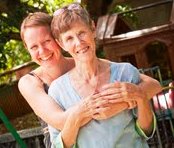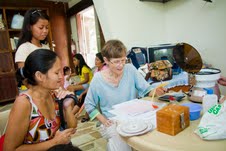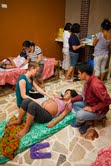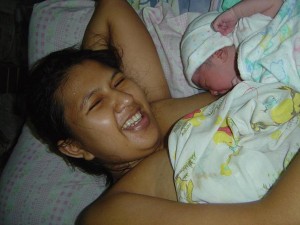‘Midwifery services are [vital] to a healthy and safe pregnancy and childbirth. Worldwide, approximately 287 000 women die every year due to pregnancy and childbirth related complications. Most of these largely preventable deaths occur in low-income countries and in poor and rural areas…Many maternal and newborn deaths can be prevented if competent midwives assist women before, during and after childbirth and are able to refer them to emergency obstetric care when severe complications arise.’
~ The World Health Organization
 According to 2009 United Nations statistics, the Philippines has a Maternal Mortality Rate (MMR) of 230 maternal deaths for every 100,000 live births, which ranks it 48th in the world, well behind its neighbours Thailand, Malaysia and Singapore. The main causes of death include haemorrhaging, high blood pressure and sepsis (blood poisoning), all of which are preventable with proper diagnosis and intervention.
According to 2009 United Nations statistics, the Philippines has a Maternal Mortality Rate (MMR) of 230 maternal deaths for every 100,000 live births, which ranks it 48th in the world, well behind its neighbours Thailand, Malaysia and Singapore. The main causes of death include haemorrhaging, high blood pressure and sepsis (blood poisoning), all of which are preventable with proper diagnosis and intervention.
The United Nations Population Fund (UNFPA) is an international development agency that promotes health and equal opportunity for all. It states that professionally trained and empowered community midwives offer the highest quality, most cost-effective access to maternal health care, and play ‘an essential role in achieving the Millennium Development Goals to reduce maternal and newborn mortality.’ Yet midwives are in short supply in most developing countries, and the World Health Organization estimates 350,000 more are needed urgently in the field.
Dr. Rosalie Paje, division chief of the Family Health Office under the Philippine Department of Health (DOH) claims that ‘midwives play a crucial role in providing maternal healthcare,’ and giving them access to further training in life-saving skills could prevent up to 80% of maternal deaths in the Philippines.
Despite these assessments, the training of midwives is erratic and midwives receive little support, meager incomes, and limited career opportunities. There is also a lack of global standardization of qualifications. And the Millennium Development Goal 5 (MDG 5) seems impossible for the Philippine government, as the country lags far behind the target of reducing the maternal mortality rate to 52 deaths per 100,000 live births.
Despite the odds against them, Jeri Gunderson, her daughter Deborah Gustafson and their  staff at the Shiphrah Birthing Home attempt to make a difference by helping as many demographically marginalized women through pregnancy and childbirth as possible. The majority of their patients have a daily income of less than US$8 a day, but as Shiphrah is also one of the cheapest birthing home around, it provides a service for the community that almost anyone can afford.
staff at the Shiphrah Birthing Home attempt to make a difference by helping as many demographically marginalized women through pregnancy and childbirth as possible. The majority of their patients have a daily income of less than US$8 a day, but as Shiphrah is also one of the cheapest birthing home around, it provides a service for the community that almost anyone can afford.
‘Shiphrah Birthing Home is … a public centre where professional midwives help deliver babies of impoverished mothers, providing pre- and postnatal care, and family planning assistance…[and promoting] well-being for pregnant mothers and newborn babies…’
Shiphrah (pronounced Shif-ra) comes from the biblical story of Moses, in which two midwifes defy Herod by preventing the genocide of Hebrew boys. Midwifery is one of the oldest professions for women, recognized not only in the Bible, but also by the Ancient Egyptians, Greek and Romans.
In 1987, Jeri Gunderson arrived in the Philippines with her missionary husband and three young children. The family moved into a five bedroom house in Tikling, where Jeri began practicing midwifery. Before long the whole house had become a cottage hospital for local pregnant women, the family squeezed into one room, as women gave birth in every available space.
 Seventeen years ago, the nursing home moved into a nearby rental property where it has been operating ever since. Last year, thanks to generous donations, they managed to buy the property and have been making gradual improvements, including a high retaining wall at the rear of the property, for safety and security.
Seventeen years ago, the nursing home moved into a nearby rental property where it has been operating ever since. Last year, thanks to generous donations, they managed to buy the property and have been making gradual improvements, including a high retaining wall at the rear of the property, for safety and security.
Winding up the steep, concrete road in a rural suburb tucked away at the far end of Ortigas Avenue, we eventually locate the Birthing Home. With roosters crowing in the background, and several small children underfoot, I wander into a large room full of women and girls in all stages of pregnancy, queuing up to be weighed and have their blood pressure taken.
As I sit amongst others patiently waiting their turn, Jeri explains that regular weighing and blood pressure tests should pick up any problems before they become a real issue, while guidance about good eating habits ensure these women maintain their health and strength throughout their pregnancies. She also believes that an experienced and observant midwife can pick up signs of stress or malnutrition with a visual inspection, without the need for invasive internal examinations or expensive ultra-sounds.
Jeri is obviously passionate about the work she has been doing in the Philippines for almost thirty years. Wiry and energetic, she moves from one topic to another – words of wisdom, statistics, introductions – at a speed that makes me wish for a tape recorder rather than my plodding pen.
Shiphrah sees approximately 1,500 pregnant women a year, of whom a third will return for  the birth of their child, in comforting surroundings and amongst familiar and caring faces. The rest will opt for home birth or hospitalization. Each week staff carry out 150 prenatal examinations and prenatal classes for up to 120 women.
the birth of their child, in comforting surroundings and amongst familiar and caring faces. The rest will opt for home birth or hospitalization. Each week staff carry out 150 prenatal examinations and prenatal classes for up to 120 women.
The staff here is loyal and long-serving, and Deborah says she rarely has to interview new staff. Many graduated from the local midwifery college, but thanks to the power of the internet, a number of interns from abroad find their way to the door from as far away as New York. Most plan to come for 2-4 months, but often end up staying longer. Shiphrah also supports the development of traditional Aeta midwives.
As we talk, a young woman is being weighed. Jeri, friendly but firm, explains that the woman’s failure to gain weight is not a good sign. It is Mary’s first pregnancy (not her real name). She is only thirteen. She is treated with the same gentle respect and patience as every other woman in the room.
Deborah takes me on a tour of the facilities and shows me recently redecorated birthing rooms, whose walls – and names – are avocado, mango and tamarind respectively. She shows me a small wooden birthing stool to illustrate how much better it is for women to give birth in an upright position rather than horizontally – accompanied by a possibly apocryphal tale of a French monarch who wanted to watch his mistresses giving birth and insisted doctors make them lie down so he could see properly through a peephole in the door!
There is also a paddling pool available for water births, although somewhat hindered by the lack of hot running water. Rooms are big enough to allow family members to share the experience. There is neither stainless steel, nor bright lights, just soft chatter and female bonding over the imminent arrival of their babies; a half-way house between home and hospital. I find myself longing to go through the whole process again in this comforting, caring and innately familiar environment.
Deborah, like her mother, is a fine-boned, slender woman, whose willowy stature belies her inner strength, and both women sincerely support dignity, health and humanity for their patients. While she admits that hospitals definitely have their place, especially for difficult births, she believes that some hospital procedures are not in the women’s best interests, as they can be ‘invasive and interruptive’, while constant internal exams can lead to infection.
 Deborah and her mother believe strongly in self-control and choice: empowering women, and giving them the right to choose where and how, even if they have no control over when. Together they work to ensure a healthy, happy and dignified mother, and the birth of her child to be a safe, nurturing, and affirming event in her life, a privilege that we from more developed countries take for granted.
Deborah and her mother believe strongly in self-control and choice: empowering women, and giving them the right to choose where and how, even if they have no control over when. Together they work to ensure a healthy, happy and dignified mother, and the birth of her child to be a safe, nurturing, and affirming event in her life, a privilege that we from more developed countries take for granted.
So count your blessings, and here’s to improving conditions for all women less fortunate than us.
*First published in ANZA News, July/August issue, 2013. Photos care of Shiphrah.

Thank you for sharing this. Jeri and her family is a blessing to us.